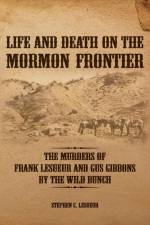av Stephen C. Lesueur
459
This thoroughly researched and vivid account examines a murderous spree by one of the West's most notorious outlaw gangs and the consequences for a small Mormon community in Arizona's White Mountains.On March 27, 1900, Frank LeSueur and Gus Gibbons joined a sheriff's posse to track and arrest five suspected outlaws. The next day, LeSueur and Gibbons, who had become separated from other posse members, were found brutally murdered. The outlaws belonged to Butch Cassidy's Wild Bunch gang. Frank LeSueur was the great uncle of the book's author, Stephen C. LeSueur.In writing about the Wild Bunch, historians have played up the outlaws' daring heists and violent confrontations. Their victims serve primarily as extras in the gang's stories, bit players and forgotten names whose lives merit little attention. Drawing upon journals, reminiscences, newspaper articles, and other source materials, LeSueur examines this episode from the victims' perspective. Popular culture often portrays outlaws as misunderstood and even honorable men-Robin Hood figures-but as this history makes clear, they were stone-cold killers who preferred ambush over direct confrontation. They had no qualms about shooting people in the back.The LeSueur and Gibbons families that settled St. Johns, Arizona, served as part of a colonizing vanguard for the Church of Jesus Christ of Latter-day Saints, popularly known as Mormons. They contended with hostile neighbors, an unforgiving environment, and outlaw bands that took advantage of the large mountain expanses to hide and escape justice. Deprivation and death were no strangers to the St. Johns colonizers, but the LeSueur-Gibbons murders shook the entire community, the act being so vicious and unnecessary, the young men so full of promise.By focusing the historian's lens on this incident and its aftermath, this exciting Western history offers fresh insights into the Wild Bunch gang, while also shedding new light on the Mormon colonizing experience in a gripping tale of life and death on the Arizona frontier.

